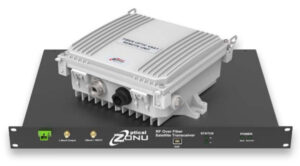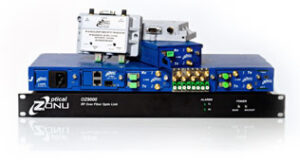RF over Fibre (RFoF)
GPS – RFoF
The GPS Over Fiber Link by Optical Zonu provides a simple, cost-effective and reliable RF connection between the GPS antenna and receivers where coaxial cable is impractical. Each link is wideband and supports any of the global GPS frequencies – current or future. The high dynamic range of the system ensures a transparent pass-through with no distortion. A low noise pre-amplifier ensures a margin on signal-to-noise ratio while keeping the signal in the most linear operating Range of the Fiber optic link. The unit housing is a compact IP-50 enclosure. The link supports one GPS antenna. A Built-in Bias-T provides the needed DC power for the active GPS antenna. While the Optical Zonu GPS Fiber Transport Link can be used for point-to-point applications, the link may also be optically split into 8 ways to provide cost-effective GPS distribution to multiple locations over lightweight Fiber cable. In addition, the receiver is available with either one or two RF outputs.
These linear RFoF Transceivers provide an excellent alternative to coaxial cable for distances from 100m to over 10 km. The standard optical connector is the SC/ APC (FC/APC is also available) for low back reflection. This, along with the integrated optical isolator, helps guarantee transparent transport without additive Noise or spurious signals.
The laser diode is an uncooled device that provides stable operation over the entire ambient Operating Temperature Range of –20 °C to +65 °C. Average Automatic Power Control (AAPC) is utilised for optimal optical power stability over the full temperature range.
The RF interface is a 50? SMA connector, and the Alarm and Monitoring Functions are available through a DB9 connector. The standard unit requires +12 VDC power between pins 4 and 5 of the DB9 connector.
The BiasT option +5V or +12V is for powering the Amplifier inside the GPS Antenna. Optical Transmitter monitors ensure the GPS is functioning correctly and if NOT, it optically reports the condition to the GPS optical receiver by blinking the light ON/OFF. The OZ600 Receiver has a built-in active DC Antenna load which goes high impedance if there is a Fibre fault or remote Antenna failure condition.
Features
- Supports GNSS, Galileo, GLONASS
- -20ºC to +65ºC TOP Range
- Provides +5 VDC DC Bias for the GPS Antenna
- No RF Sensitivity Impact
- Patented Optical Antenna Alarm Reporting
- 20 dB Gain Supports Optical Splitting for GPS Distribution
- Laser Conforms to Class 1 Emission Level and IEC-825 (EN 60825) standard

Satcom over Fibre
The L/S Band Satcom Fiber Transport Link by Optical Zonu provides a simple, cost-effective and reliable RF connection between your satellite antenna and modem in those instances where coaxial cable is impractical or additional security is required. Each fibre link supports all frequencies from 950 MHz to 2300 MHz. The high dynamic range of the system ensures a transparent pass-through with no distortion. A low noise pre-amplifier in the downlink path ensures a margin on signal-to-noise ratio while keeping the signal in the most linear operating range of the fibre optic link.
For Tx/Rx sites, the low phase noise 10 MHz reference can be included without any impact on the L/S band performance. Other fibre optic products that combine the 10 MHz reference with the primary signal either cause degradation of the primary through mixing or poor phase noise if the reference level is too low. The Optical Zonu L/S Band Satcom Fiber Transport Link utilizes a 4 channel Coarse Wave Division Multiplexer (CWDM) to ensure that there is no mixing among all the supported signals, guaranteeing the highest signal purity. The system is modular and can be configured for Transmit/Receive or Receive Only with options for a 10 MHz Reference Signal, DC Power for the LNB and an FSK or E-Net data connection between the sites.
Major Features and Benefits
- L/S Band Fiber Optic Link Between the Satellite Modem And ODU
- IP-67 Remote Unit Connects to ODU
- Modular, Rack-Mounted Master Unit
- Transmit/Receive or Receive Only
- Separate Optional 10 MHz Path – No Mixing, Lowest Phase Noise
- Optional DC Power to LNB
- Optional Ethernet or FSK Data Connection Between Sites
RFoF – RF over Fibre Optic
RF over Fibre (RFoF), sometimes called RF over Glass (RFoG), is a mature technology becoming increasingly popular across many industry sectors such as Defence, Satcom, Broadcast, Infrastructure, Telecommunication and Mining.
RFoF is well suited for applications where distance or other factors become problematic with traditional coaxial cable installs. RFoF is used to connect antennas to transmission and receiving equipment. Rojone and our US partner Optical Zonu can provide a wide range of solutions from day to day in building conversion to more complex demanding solutions challenges. With a frequency range suitable for transporting across all HF, VHF, UHF, L, S, C, X, Ku, K and Ka bands (10 MHz to 40 GHz).
Advantages
The transmission of RF and Microwave Signals via waveguides or coaxial cable suffers high insertion
loss a nd susceptibility to interference (EMI). Single Mode RFoF transceivers provide an excellent alternative for this type of application. Fibre Optic transmission offers significant advantages for the reliable transport of RF signals in their native format over many optical networks and across a broad range of frequencies. For analogue type signals, especially at high frequencies, premium performance at high Spurious Free Dynamic Range (SFDR) is desirable.
nd susceptibility to interference (EMI). Single Mode RFoF transceivers provide an excellent alternative for this type of application. Fibre Optic transmission offers significant advantages for the reliable transport of RF signals in their native format over many optical networks and across a broad range of frequencies. For analogue type signals, especially at high frequencies, premium performance at high Spurious Free Dynamic Range (SFDR) is desirable.
- Less signal degradation per meter
- Higher signal carrying capacity/bandwidth
- Less costly per metre
- Lighter and thinner than traditional coaxial cable
- Free from electromagnetic interference (Poor weather does not affect signal)
- Lower transmitter launching power
Applications
- Cellular wireless
- Public safety
- Network sync
- Satellite earth stations
- Defence applications


